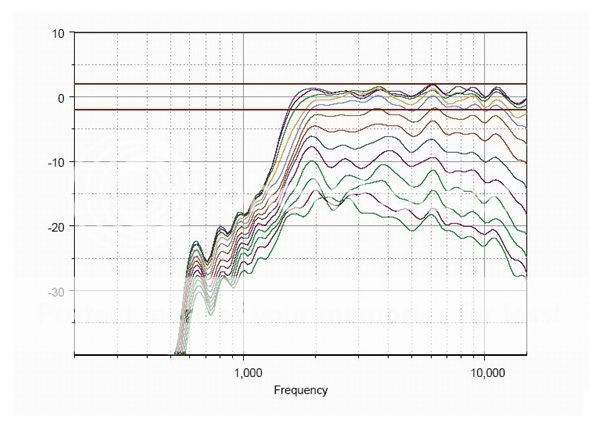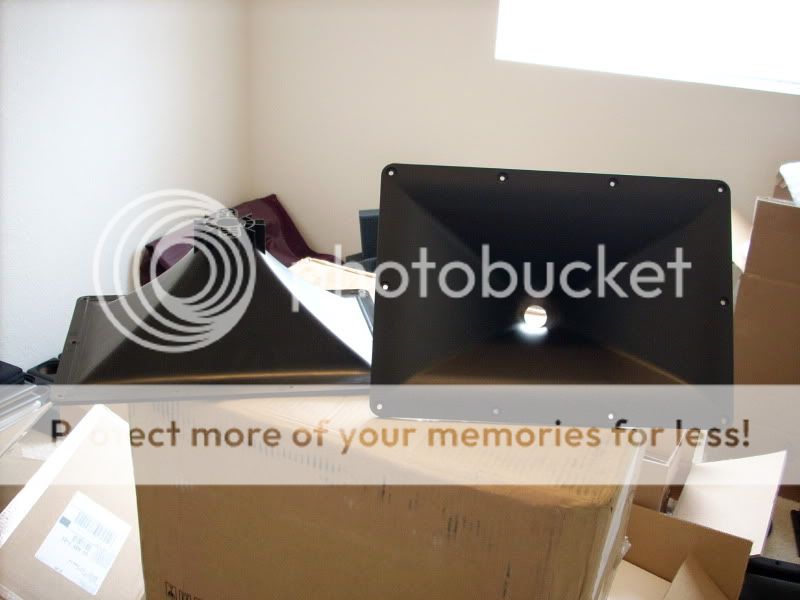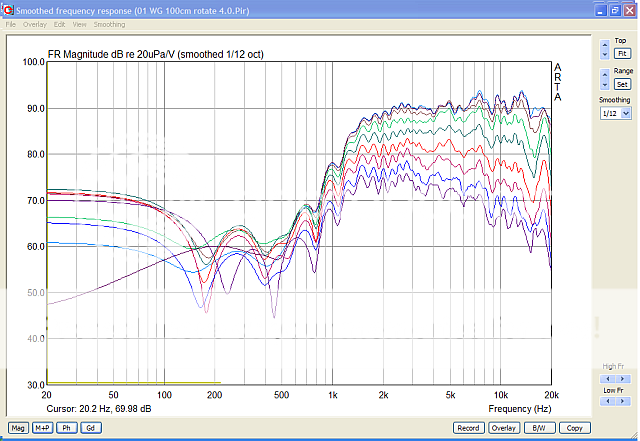This afternoon I was messing around with the wavefront simulator in Hornresp, and discovered something very interesting:
If there's any diffraction at the mouth of a waveguide, the wavefront doesn't radiate the way that it's supposed to.
Simulators are great for design, but what's more important is the implementation and the 'sum of all things' acoustically. For example my econowaves polar response is great even without roundover/rebate etc.


Pyle wg + DE250 shown.
Most horn implementations could be flawed - horns themselves are not IMHO flawed. Not at any frequency (however I prefer ribbon tweeters for 12000Hz up duties.
Mixing horns with radiating drivers is frought with problems and compromises. Compression drivers / horns and radiator drivers as the cone cannot keep up.
Once you start using a good compression driver on the right horn for mid rand / upper mid range you hear the inadequacies of non horn bass - so the chase begins. Farty boom boxes and subs just do not cut it...
You need to end up with Front Loaded horn bass - big but beautiful in sound, if done right. Ok, I compromise a bit with 15" drivers and exponential flare for my mid bass horns and tapped horns on deep bass duty. Gotta fit in a fairly normal size room after all. Still, they take you breath away at dynamics, pace and tone.
Requiring a horn to cover too wide a freq range is another chief culprit in flawed implementations. You get colourations. So we end up with a 4 or preferably 5 way.
A vertical stack is much better than a horizontal arrangement.
Next up is time alignment. Often overlooked but once you have got a good working horn system it adds extra cohesion most definitely.
Active DSP X/O is sensible and the excellent offerings from WAF Najda and miniDSP make it the sensible thing to do. Having messed about with passives and gone DSP there is NO turning back. The benefits outweigh other issues.
So, to answer the question, Yes most implementations you see / hear are flawed. However that doesn't mean you can't buy (given enough cash), or create something that is so much better than 'normal' speakers and so good that flawed is not a thought that would ever remotely come to mind.
All other speaker implementations that pertain to high quality playback are again, IMHO, less than ideal.
Mixing horns with radiating drivers is frought with problems and compromises. Compression drivers / horns and radiator drivers as the cone cannot keep up.
Once you start using a good compression driver on the right horn for mid rand / upper mid range you hear the inadequacies of non horn bass - so the chase begins. Farty boom boxes and subs just do not cut it...
You need to end up with Front Loaded horn bass - big but beautiful in sound, if done right. Ok, I compromise a bit with 15" drivers and exponential flare for my mid bass horns and tapped horns on deep bass duty. Gotta fit in a fairly normal size room after all. Still, they take you breath away at dynamics, pace and tone.
Requiring a horn to cover too wide a freq range is another chief culprit in flawed implementations. You get colourations. So we end up with a 4 or preferably 5 way.
A vertical stack is much better than a horizontal arrangement.
Next up is time alignment. Often overlooked but once you have got a good working horn system it adds extra cohesion most definitely.
Active DSP X/O is sensible and the excellent offerings from WAF Najda and miniDSP make it the sensible thing to do. Having messed about with passives and gone DSP there is NO turning back. The benefits outweigh other issues.
So, to answer the question, Yes most implementations you see / hear are flawed. However that doesn't mean you can't buy (given enough cash), or create something that is so much better than 'normal' speakers and so good that flawed is not a thought that would ever remotely come to mind.
All other speaker implementations that pertain to high quality playback are again, IMHO, less than ideal.
Last edited:
Really! Care to share what those might be? I only know of one. It would be great to know the other ones.
Hi Dr. Geddes,
Are you going to be at AES in a few weeks?
With ur speakers?
Would enjoy meeting you and hearing your speakers for sure.
Your theory on HOMs may well be correct, I can't say.
Some have questioned their existence.
I've never seen an HOM, but I haven't seen an electron either...
... I have wondered if the foam is simply attenuating the HF reflections from the mouth that are normally along to the main axis as well as giving the driver an acoustically more resistive load. Nothing wrong with that, especially if it results in an improved sound quality.
_-_-
Hi Bear
No, I don't go to AES anymore, now that I have to pay the bills myself. Too expensive for too little obtained.
And I have not shown my speakers at a show in nearly five years - it's basically a waste of time.
That HOMs exist is irrefutable, but one could argue that they aren't audible. I would, of course, argue that they are, but one could argue that they aren't.
The foam does attenuate the internal reflections, that is certainly true, and that certainly IS a good thing in and of itself. But that this is the only effect and that HOM reduction is not a significant aspect of the problem is not well established (by me or anyone else) so any nay-sayers are just guessing. But this audio where guesses are usually stated as facts.
No, I don't go to AES anymore, now that I have to pay the bills myself. Too expensive for too little obtained.
And I have not shown my speakers at a show in nearly five years - it's basically a waste of time.
That HOMs exist is irrefutable, but one could argue that they aren't audible. I would, of course, argue that they are, but one could argue that they aren't.
The foam does attenuate the internal reflections, that is certainly true, and that certainly IS a good thing in and of itself. But that this is the only effect and that HOM reduction is not a significant aspect of the problem is not well established (by me or anyone else) so any nay-sayers are just guessing. But this audio where guesses are usually stated as facts.
For example my econowaves polar response is great even without roundover/rebate etc.
Pyle wg + DE250 shown.
It takes a very high resolution polar map to see the mouth diffraction and your plots are certain not very high resolution. Enough smoothing makes anything look good.
It takes a very high resolution polar map to see the mouth diffraction and your plots are certain not very high resolution. Enough smoothing makes anything look good.
How about this one, my understanding is that this is your measurement of the above Pyle horn. Certainly looks *very* good to me!

It takes a very high resolution polar map to see the mouth diffraction and your plots are certain not very high resolution. Enough smoothing makes anything look good.
http://www.diymobileaudio.com/forum/1976798-post48.html
Here's a measurement that illustrates this.
It's the same tweeter, but in two different tweeter pods.
See how the off axis response is closer to the on axis response in the second one?
This is due to an improved round over.
It's easy to see the effect in Hornresps wave simulator.
Basically a big round over reduces the effect of side lobes.
And it's these side lobes, from diffraction, that change the polar response.
Measurements courtesy of Hanatsu from here: Car Audio | DiyMobileAudio.com | Car Stereo Forum - View Single Post - Smoke and Mirrors
Last edited:
Funny how this almost comes full circle. I designed that pod for Hanatsu inspired by your thread on diyma about spheres: Improve Your Soundstage for $2 - Car Audio | DiyMobileAudio.com | Car Stereo Forum
And now you're using it as an example 😉.
It is based on the pod for my own car:

And now you're using it as an example 😉.
It is based on the pod for my own car:

Last edited:
How would one explain that there are *heaps* of non-roundover waveguides with their excellent polar response ?
Another popular example:


Another popular example:

Gainphile, the last horn you show does have a smooth transition out to 90 degrees. That is far preferable to the typical sharp edge that was standard for so many years.
It's a little unclear what is going on back at the throat, but that's not what we're discussing right now.
So, I'd say this represents an improvement over the sharp edged horns for certain.
It's a little unclear what is going on back at the throat, but that's not what we're discussing right now.
So, I'd say this represents an improvement over the sharp edged horns for certain.
Gainphile, the last horn you show does have a smooth transition out to 90 degrees. That is far preferable to the typical sharp edge that was standard for so many years.
Exactly.
How about these. Sharp edge, yet smooth response to 90deg. Note that it's unsmoothed 1/12 oct. so you can see all the wriggles.

An externally hosted image should be here but it was not working when we last tested it.

A foam rim will smooth it right out. If it's like Altec horns, the foam needs to overhang the termination a little.
GM
GM
How about these. Sharp edge,
That edge is not that sharp. Are you saying that you don't believe that a sharp edge has diffraction?
How would one explain that there are *heaps* of non-roundover waveguides with their excellent polar response ?
Another popular example:


It looks like there are ca. 3kHz and ca. 8kHz dips, and possibly something at 6kHz...
It is as simple as to calculate the distances 3kHz, 6kHz and 8kHz gives..
Then I expect you get the two - three dimensions of this device.
And even if not the worst I have seen it is obviously not perfect..
I made a not optimal shape and terminations of my very first waveguides, but as I could calculate where the problem was from the measurements I was able to cure the problem quickly.
That edge is not that sharp. Are you saying that you don't believe that a sharp edge has diffraction?
It looks sharp to me! 😕 ... and I've held them on my hands.
All these things I posted were showing good polars can be had with normal "sharp" horns ...
You are missing the point. Mouth diffraction has very little effect on the polars, but it is quite audible as a problem. And you didn't answer my question.
What do you mean? We were discussing polar response and now you're saying it has little do do with it?
Original post:
As my examples shown, the same can be achieved either way?
Original post:
Completely changes the wavefront doesn't it? It takes a chaotic wavefront and makes it smooth. It improves the polar response. It improves the on-axis response.
If there was ever a 'free lunch' in audio, this is it.
As my examples shown, the same can be achieved either way?
I will make a prediction here....
"Horn flaws suck less than room flaws" 🙂
- Status
- Not open for further replies.
- Home
- Loudspeakers
- Multi-Way
- Are Most Horns Fundamentally Flawed?